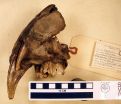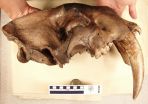"For predators such as big cats, an important determinant of an individual's full hunting ability is the time required to grow their weapons--their teeth," said Z. Jack Tseng, a National Science Foundation and Frick Postdoctoral Fellow in the American Museum of Natural History's Division of Paleontology and a coauthor on the new paper. "This is especially crucial for understanding sabertoothed predators such as Smilodon."
S. fatalis lived in North and South America until going extinct about 10,000 years ago. About the size of a modern tiger or lion but more solidly built, the cats are famous for their protruding canines, which could grow to be 18 centimeters (about 7 inches) long. Although well-preserved fossils of S. fatalis are available to researchers, very little is known about the absolute ages at which the animals reached key developmental stages.
"Timing of development is critical for many aspects of vertebrate ecology and evolution," said Robert Feranec, curator of Pleistocene vertebrate paleontology at the New York State Museum and the corresponding author on the paper. "Changes in the timing of life-history events can have major effects on an organism's adult features and final appearance. For extinct species, we can usually only determine the relative sequence of developmental events. This technique will permit the determination of absolute developmental age not only for Smilodon, but other extinct species."
Using S. fatalis specimens recovered from the La Brea Tar Pits in Los Angeles, Feranec, Tseng, and colleagues from Clemson University and the Neural Stem Cell Institute combined data from stable oxygen isotope analyses and micro-computed tomography (μCT) to establish the eruption rate for the saber-toothed cat's permanent upper canines. At 6 millimeters per month, the calculated eruption rate is speedy--for comparison, human fingernails grow at about 3.4 millimeters per month.
By using the eruption rate to calibrate a previously published tooth-replacement sequence for the saber-toothed cat, the researchers calculated the timing of various growth events in absolute units (months), as opposed to the relative timing used in all previous research on this animal.
S. fatalis, like many other mammals, had two sets of teeth in its lifetime, and the first stopped erupting when the cub was about one-and-a-half years old. Toward the end of the eruption of the baby teeth, the permanent teeth started to erupt, with about an 11-month period where both sets of saber teeth could be seen inside of a cub's mouth.
As in human babies, the cubs of S. fatalis had loosely fitted pieces of bones in their skulls that fuse over time. The two parietal bones at the back of the cats' skulls were where their main jaw muscles attached, making the bones' fusion a necessity for supporting forces that enable them to eat larger chunks of meat or hunt larger prey. In S. fatalis, parietal bone fusion happened when the cubs were between one and one-and-a-half years old, about eight months earlier than is seen in modern lions. The timing coincides with the full eruption of the baby canines.
"This means that the jaw muscles of these cubs were anatomically ready to be used in hunting early on with their loaner set of sabers," Tseng said.
After about 20 months, the cats shed their baby canines, and the permanent ones continued to grow until the animals were between three to three-and-a-half years old, later than seen in modern large cats like tigers, leopards, and lions, but not as late as might be expected, the researchers said.
"Despite having canine crown heights that were more than twice those of the lion, Smilodon didn't require twice as much time to develop its canines," said Aleksander Wysocki, a graduate student at Clemson University and lead author on the paper.
Based on the results, young cats--less than 4-7 months old--are extremely rare in the vast collections from the La Brea Tar Pits.
"Considering the abundance of predators at Rancho La Brea, younger cubs would have been at risk of being preyed upon themselves if they attempted to feed on the animals trapped within the tar pits," Wysocki said. "The cubs probably remained hidden or at den sites while the adults pursued prey trapped in the tar pits and never made it back out."
The researchers say that the technique they demonstrate in the paper could be applied to a variety of extinct species to better understand the manner and rate by which different animals grew, for example, by looking at the tusks of extinct elephants or marine mammals.
INFORMATION:
Funding for this work was provided by the Society of Vertebrate Paleontology, University of California-Berkeley's Department of Integrative Biology, the American Museum of Natural History's Theodore Roosevelt Grant and National Science Foundation (NSF) Doctoral Dissertation Improvement Grant. Z. Jack Tseng is supported by NSF Grant #DEB-1257572.
AMERICAN MUSEUM OF NATURAL HISTORY (AMNH.ORG)
The American Museum of Natural History, founded in 1869, is one of the world's preeminent scientific, educational, and cultural institutions. The Museum encompasses 45 permanent exhibition halls, including the Rose Center for Earth and Space and the Hayden Planetarium, as well as galleries for temporary exhibitions. It is home to the Theodore Roosevelt Memorial, New York State's official memorial to its 33rd governor and the nation's 26th president, and a tribute to Roosevelt's enduring legacy of conservation. The Museum's five active research divisions and three cross-disciplinary centers support approximately 200 scientists, whose work draws on a world-class permanent collection of more than 33 million specimens and artifacts, as well as specialized collections for frozen tissue and genomic and astrophysical data, and one of the largest natural history libraries in the world. Through its Richard Gilder Graduate School, it is the only American museum authorized to grant the Ph.D. degree. In 2012, the Museum began offering a pilot Master of Arts in Teaching program with a specialization in Earth science, which is the only non-university affiliated such program in the United States. Annual attendance has grown to approximately 5 million, and the Museum's exhibitions and Space Shows can be seen in venues on five continents. The Museum's website and collection of apps for mobile devices extend its collections, exhibitions, and educational programs to millions more beyond its walls. Visit amnh.org for more information.
Follow
Become a fan of the Museum on Facebook at facebook.com/naturalhistory, follow us on Instagram at @AMNH, Tumblr at amnhnyc or visit twitter.com/AMNH to follow us on Twitter.




